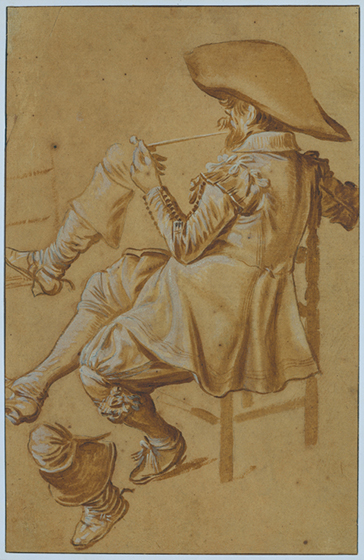Drawings for Paintings in the Age of Rembrandt

Michiel van Musscher, An Artist in His Studio with His Drawings, mid-1660s, oil on panel, Liechtenstein, The Princely Collections, Vaduz-Vienna
This work beautifully illustrates how Dutch artists referred to their drawings when composing their paintings. Here, an artist mixes paints with a palette knife while holding his brushes as he makes a preliminary oil sketch on his canvas based on the drawings spread out near his feet.

Rembrandt van Rijn, Old Man Seated, 1631, chalk on prepared paper, Private Collection
Rembrandt’s command of red chalk is exquisitely demonstrated in this sketch, with a range of tones capturing the light and shadow that fall on the man. Rembrandt used the figure to represent the Old Testament patriarch Jacob in Joseph Telling His Dreams, the oil sketch seen in the following slide.

Rembrandt van Rijn, Joseph Telling His Dreams, 1633, grisaille, Rijksmuseum, Amsterdam, purchased with the support of the Vereniging Rembrandt and the Stichting tot Bevordering van de Belangen van het Rijksmuseum

Jan Lievens, Forest Interior with a Draftsman, 1660s, pen and ink with wash, Maida and George Abrams Collection, Boston

Aelbert Cuyp, Calcar with Monterberg in the Distance, early 1640s, chalk, wash, watercolor, partly brushed with gum arabic, Lent by The Metropolitan Museum of Art, From the Collection of Rita and Frits Markus, Bequest of Rita Markus, 2005
This drawing was originally part of a large sketchbook that Cuyp took with him on his travels along the Rhine River in the early 1640s.

Balthasar van der Ast, Study of a Tulip and a Fly, 1620 – 1630, gouache, watercolor, and tempera, Fondation Custodia, Collection Frits Lugt, Paris
Meticulous studies of the natural world allowed Van der Ast to paint bouquets composed of flowers that actually bloomed at different times of the year. This tulip appears in the following still life, albeit slightly more closed than in the drawing.

Balthasar van der Ast, Flower Still Life, c. 1630, oil on panel, Rose-Marie and Eijk Van Otterloo Collection

Hendrick Avercamp, A Standing Girl with Her Hands under Her Apron, c. 1620, chalk, Lent by Her Majesty Queen Elizabeth II
Avercamp sketched both outdoors and in the studio, where he posed models in costumes appropriate for his paintings. This girl is shown standing on skates in the center left foreground of the painting on the following slide, watching elegant people in a horse-drawn sled.

Hendrick Avercamp, A Scene on the Ice, c. 1625, oil on panel, National Gallery of Art, Washington, Ailsa Mellon Bruce Fund

Gerrit Berckheyde, Standing Woman, chalk, Fondation Custodia, Collection Frits Lugt, Paris
This woman, wearing a peasant dress and holding a glass, also appears in the next drawing by Cornelis Bega. The two figures correspond so closely that it seems clear both artists sketched the model during the same session at a drawing academy, but from slightly different angles.

Cornelis Bega, Peasant Woman, Turned Three-Quarters to the Left, Holding a Glass, chalk, The Samuel Courtauld Trust, The Courtauld Gallery, London

Gerrit Berckheyde, View of the Nieuwezijds Voorburgwal in Amsterdam, graphite, pen, and ink, Koninklijk Oudheidkundig Genootschap, Amsterdam
Berckheyde’s detailed, highly accurate drawing of the rear of Amsterdam’s town hall (the canal has since been filled in) served as inspiration for five paintings, including the one in the following slide.

Gerrit Berckheyde, The Nieuwezijds Voorburgwal with the Flower and Tree Market in Amsterdam, c. 1675, oil on wood, Los Angeles County Museum of Art, Gift of Mrs. Edward W. Carter, 2009

Abraham Bloemaert, Studies of Legs, Feet, and a Young Man Leaning, chalk, some pen and ink Rijksmuseum, Amsterdam

Salomon de Bray, The Twins Clara and Albert de Bray, August 12, 1646, chalk, The Morgan Library & Museum, New York, Purchased in 1909
When De Bray used this drawing for his painting of the twins (next slide), he made a number of adjustments: here the children are asleep, but there they are wide awake; he also transformed their simple wicker basket into an ornate crib.

Salomon de Bray, The Twins Clara and Albert de Bray, 1646 or after, oil on canvas, National Galleries of Scotland, Edinburgh, Long loan in 1995

Dirck Hals, Sitting Pipe Smoker, 1622 – 1627, brush and ink with oil paint, heightened with white, over a sketch in chalk, Rijksmuseum, Amsterdam
To satisfy the high demand for his scenes of merry companies enjoying food and drink, Hals turned to his portfolio of figure studies, combining them in various arrangements and adapting them to suit his painterly needs. In this drawing the artist provided himself with more design options by giving the man two extra legs.

Jacob van Ruisdael, View over Amsterdam and the IJ, c. 1665, chalk and wash, Rijksmuseum, Amsterdam
Despite its tiny size, this drawing captures the sense of a bustling city densely packed with houses, and it served as the basis for the evocative painting in the following slide. Ruisdael apparently sketched the scene from scaffolding erected for the construction of the cupola on Amsterdam’s new town hall.

Jacob van Ruisdael, Panoramic View of Amsterdam, Its Harbor, and the IJ, c. 1665 – 1670, oil on canvas, Private Collection

Pieter Jansz Saenredam, Saint Bavo, Haarlem, Part of the Nave, 1635, pen and chalk on blue paper, Noord-Hollands Archief, Kennemer Atlas, Haarlem
After drawing this freehand sketch of the church, Saenredam perfected his design and perspective system with a ruler and compass in a large construction drawing, which enabled him to transfer the scene to a wood panel before painting it.

Pieter Jansz Saenredam, Interior of Saint Bavo’s Church, Haarlem, 1635, pen and ink with wash and touches of chalk over graphite, National Gallery of Art, Washington, Gift of Dian Woodner